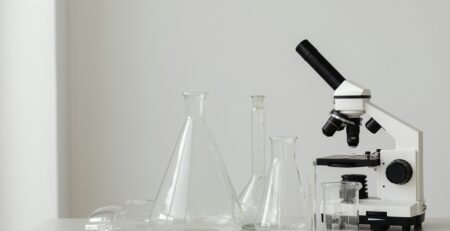4
Sep
Volumetric Flasks in Analytical Chemistry: Accuracy Standards Explained
In analytical chemistry, accuracy is everything. Whether preparing a standard solution or performing titrations, laboratories rely on volumetric flasks for precise liquid measurement. Manufactured from BORO 3.3 borosilicate glass, volumetric flasks are designed to meet strict international standards, ensuring reliability in Australian schools, universities, and research laboratories.
What Defines a Volumetric Flask?
A volumetric flask is a calibrated vessel with a narrow neck and a single graduation mark.
- Designed to measure one specific volume with exceptional accuracy.
- Available in a range of capacities, from 1 mL to 2 L.
- Supplied in Class A (highest accuracy, individually calibrated) and Class B (general-purpose use).
- Often paired with ground glass stoppers or plastic caps for secure sealing.
These design features make volumetric flasks critical for high-precision laboratory work.
Accuracy Standards: Class A vs Class B
Volumetric flasks are manufactured according to ISO 1042 and ASTM E288 standards.
- Class A flasks: Tightest tolerances, often supplied with calibration certificates. Used in research, pharmaceuticals, and regulatory labs.
- Class B flasks: Wider tolerances, more economical, suitable for teaching and routine tasks.
Both classes are reliable, but only Class A ensures the reproducibility required for analytical chemistry.
Advantages of Borosilicate Glass Construction
- Thermal resistance: Withstands heating, cooling, and autoclaving.
- Chemical durability: Resistant to acids, alkalis, and solvents.
- Clarity: Allows accurate meniscus reading at the calibration line.
- Longevity: Durable and reusable, reducing lab waste compared to plastics.
Comparison Table: Class A vs Class B Volumetric Flasks
| Feature | Class A Volumetric Flask | Class B Volumetric Flask |
|---|---|---|
| Accuracy / Tolerance | Highest precision, ISO 1042 & ASTM E288 | Wider tolerance, general-purpose use |
| Calibration | Individually certified | Bulk manufactured, no certificate |
| Cost | Higher | Lower |
| Best Applications | Analytical chemistry, pharmaceuticals, QC | Educational labs, routine measurements |
| Material | BORO 3.3 Borosilicate Glass | BORO 3.3 Borosilicate Glass |
Applications in Analytical Chemistry
- Standard solution preparation: Creating solutions with precise molar concentrations.
- Titrations: Ensuring reproducible results by using accurately measured solutions.
- Pharmaceutical QC: Meeting GMP and ISO regulatory compliance.
- Environmental testing: Preparing solutions for trace analysis.
FAQs
Q1: Why are volumetric flasks narrow-necked?
The narrow neck minimises meniscus error, ensuring high accuracy when filling to the calibration mark.
Q2: Do all analytical labs require Class A flasks?
Yes, for accredited and regulated work, Class A is required. Class B may be used for teaching or non-critical applications.
Q3: Can volumetric flasks be autoclaved?
Yes, BORO 3.3 flasks can be sterilised safely, though printed graduations should be protected from excessive wear.
Q4: How can I extend the life of a volumetric flask?
Handle with care, avoid sudden temperature changes, and clean using non-abrasive detergents.
References
- ISO 1042: Laboratory Glassware — One-mark Volumetric Flasks.
- ASTM E288: Standard Specification for Volumetric Glassware.
- ISO 3585: Borosilicate Glass 3.3 — Technical Properties.
- University of Sydney Analytical Chemistry Laboratory Guide.
- NIST Chemistry WebBook, National Institute of Standards and Technology.

